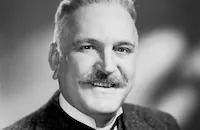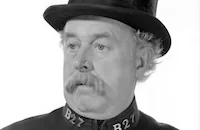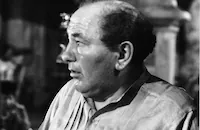Enchanted April
Brief Synopsis
Cast & Crew
Harry Beaumont
Ann Harding
Frank Morgan
Katharine Alexander
Reginald Owen
Jane Baxter
Film Details
Technical Specs

Synopsis
At a Hempstead club for housewives, lonely and neglected Lotty Wilkins convinces husband-dominated Rose Arbuthnot to join her for a one-month holiday in Italy. Lotty, whose husband Mellersh, a former researcher at the British Library, became a popular romance novelist at her urging and then was transformed into a "ladies man," arranges with Rose to rent an Italian castle with two other English women for the month of April. When they arrive at San Salvatore, Lotty and Rose are surprised to discover that their co-renters, Lady Caroline Dester and Mrs. Phoebe Brockwell Templeton Fisher, have already moved in and have claimed the best rooms for themselves. Rose, whose husband Henry is a pompous London lawyer, is particularly disappointed to have her position as the castle hostess taken over by the dour and bossy Mrs. Fisher. In spite of the castle's primitive amenities and Mrs. Fisher's stuffiness, Lotty and Rose determine to enjoy themselves and write their husbands of their adventures. As Lotty, a self-proclaimed "seer," had predicted to Rose, Henry shows up at San Salvatore, but only seems to want to ingratiate himself with Lady Caroline and Mrs. Fisher. While Rose and Henry, whose demeanor softens in the romantic atmosphere of the castle, become re-acquainted, Mrs. Fisher also falls under San Salvatore's spell. To Lotty's joy, Mrs. Fisher extends a warm dinner invitation to artist Peppo Briggs, the castle's owner. Unknown to Lotty, however, Mellersh is looking for Lady Caroline, with whom he is infatuated, in London. When Mellersh hears that Lady Caroline, who knows him only by his "pen" name, is in Italy, he looks her up at the castle, unaware that Lotty is also there. Before he can put himself in a compromising situation, Lotty showers her husband with grateful kisses and professes her love. Overwhelmed by his wife's affections, Mellersh happily returns her love, while Mrs. Fisher allows Rose to act as hostess, and Lady Caroline warms to Briggs.

Director

Harry Beaumont
Cast

Ann Harding

Frank Morgan

Katharine Alexander

Reginald Owen
Jane Baxter

Ralph Forbes

Jessie Ralph

Charles Judels

Rafaela Ottiano
Crew

Film Details
Technical Specs

Articles
Enchanted April (1935)
Von Arnim, an Australian-born British novelist, wrote the book at a troubled time in her own life, and in the Italian castle that was the real-life model for San Salvatore. Married for the first time to a domineering German count, von Arnim had turned to writing to support her family when her spendthrift husband went to prison for fraud. After his death, the now-successful widow had affairs with H.G. Wells and with Sir Francis Russell, whom she married impulsively and disastrously. When that marriage fell apart, von Arnim retreated to Italy and found solace in writing Enchanted April.
Ann Harding had been a Broadway leading lady who went to Hollywood at the beginning of the talkie era in 1929. Her naturalistic acting was a welcome change from the mannered style of some of the former silent screen stars, and she became one of RKO's biggest stars, particularly in women's pictures, where her warmth and honesty made even the most sentimental or sordid sagas appealing. But by the mid-1930s, she was being typecast, and the public was tiring of her self-sacrificing heroines. Harding, too, was tiring of those roles, and she and the studio were at odds about the course of her career. The dignified Harding seems miscast as the flaky Lotty in Enchanted April, although her performance is charming as usual.
The standout performances in Enchanted April are by two comic veterans. As the formidable Mrs. Fisher, Jessie Ralph steals every scene she's in and Reginald Owen turns his every scene into a comic aria as the barrister with delusions of grandeur. Nobody played foolish husbands as well as Frank Morgan, and he did so again in Enchanted April. Ralph Forbes, who plays the artist-landlord, was usually cast as stalwart heroes, but has fun with a more flamboyant character. Katharine Alexander, who plays Rose, was primarily a stage actress who was somewhat colorless in films. Enchanted April was one of only two American films British actress Jane Baxter made - she was better known as a film, theater, and television actress in England.
With little more than an hour running time, Enchanted April seemed rushed and superficial to some critics. And the beauty and transformative power of the location are only talked about, but never seen. The film was a box-office flop, and apparently hastened the demise of Harding's film career. She left films in 1937, after her marriage to a composer, although she returned to the screen occasionally. Harding continued to work frequently on stage, and later in television. Her final film appearance was in The Man in the Gray Flannel Suit (1956), opposite Fredric March, who had been her co-star in her film debut, Paris Bound (1929).
Enchanted April was remade more successfully in 1992, directed by Mike Newell and shot in the castle where Elizabeth von Arnim had written the novel. This time, the beauty of Italy glowed in the color cinematography, and worked its seductive magic on audiences as well as on the four unhappy heroines. The film was a worldwide hit, and earned three Academy Award nominations.
Director: Harry Beaumont
Producer: Kenneth Macgowan
Screenplay: Samuel Hoffenstein & Ray Harris, based on the play by Kane Campbell and the novel by Elizabeth von Arnim
Cinematography: Edward Cronjager
Editor: George Hively
Art Direction: Carroll Clark, Van Nest Polglase
Principal Cast: Ann Harding (Mrs. Lotty Wilkins), Frank Morgan (Mellersh Wilkins), Katharine Alexander (Mrs. Rose Arbuthnot), Reginald Owen (Henry Arbuthnot), Jane Baxter (Lady Caroline Dester), Ralph Forbes (Peppo Briggs), Jessie Ralph (Mrs. Phoebe Fisher), Charles Judels (Domenico), Rafaela Ottiano (Francesca).
BW-66m. Closed captioning.
by Margarita Landazuri

Enchanted April (1935)
Quotes
Trivia
Notes
According to an early Hollywood Reporter production chart, Rosalie Stewart and playwright Kane Campbell wrote an adaptation for this production, but their contribution to the completed film has not been determined. Hollywood Reporter production charts list the following additional cast members: Gwendolyn Logan, May Beatty, Hector Sarno, Doris Lloyd, Charlotte Granville, Henry Armetta, Inez Palange and Eric Blore. Their participation in the final film has not been confirmed. RKO borrowed Frank Morgan from M-G-M for this production. Preview running times suggest that the studio edited the film by at least twelve minutes before its general release. A British version of Elizabeth's novel, also entitled Enchanted April, starring Miranda Richardson and Joan Plowright and directed by Mike Newell, was released in the U.S. in 1992.














